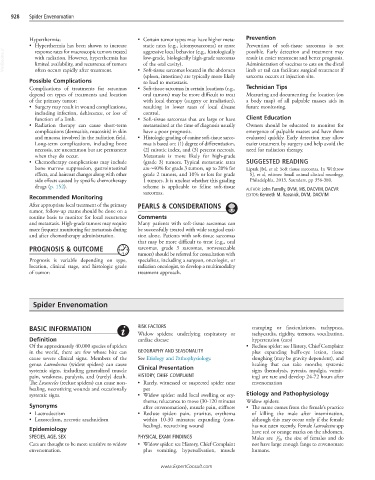Page 1847 - Cote clinical veterinary advisor dogs and cats 4th
P. 1847
928 Spider Envenomation
Hyperthermia: • Certain tumor types may have higher meta- Prevention
• Hyperthermia has been shown to increase static rates (e.g., leiomyosarcoma) or more Prevention of soft-tissue sarcomas is not
VetBooks.ir with radiation. However, hyperthermia has low-grade, biologically high-grade sarcomas result in easier treatment and better prognosis.
response rates for macroscopic tumors treated
aggressive local behavior (e.g., histologically
possible. Early detection and treatment may
of the oral cavity).
Administration of vaccines to cats on the distal
limited availability, and recurrence of tumors
often occurs rapidly after treatment.
• Soft-tissue sarcomas located in the abdomen
(spleen, intestines) are typically more likely limb or tail can facilitate surgical treatment if
sarcoma occurs at injection site.
Possible Complications to lead to metastasis.
Complications of treatments for sarcomas • Soft-tissue sarcomas in certain locations (e.g., Technician Tips
depend on types of treatments and location oral tumors) may be more difficult to treat Measuring and documenting the location (on
of the primary tumor: with local therapy (surgery or irradiation), a body map) of all palpable masses aids in
• Surgery may result in wound complications, resulting in lower rates of local disease future monitoring.
including infection, dehiscence, or loss of control.
function of a limb. • Soft-tissue sarcomas that are large or have Client Education
• Radiation therapy can cause short-term metastasized at the time of diagnosis usually Owners should be educated to monitor for
complications (dermatitis, mucositis) in skin have a poor prognosis. emergence of palpable masses and have them
and mucosa involved in the radiation field. • Histologic grading of canine soft-tissue sarco- evaluated quickly. Early detection may allow
Long-term complications, including bone mas is based on: (1) degree of differentiation, easier treatment by surgery and help avoid the
necrosis, are uncommon but are permanent (2) mitotic index, and (3) percent necrosis. need for radiation therapy.
when they do occur. Metastasis is more likely for high-grade
• Chemotherapy complications may include (grade 3) tumors. Typical metastatic rates SUGGESTED READING
bone marrow suppression, gastrointestinal are ≈40% for grade 3 tumors, up to 20% for Liptak JM, et al: Soft tissue sarcomas. In Withrow
effects, and haircoat changes along with other grade 2 tumors, and 10% or less for grade SJ, et al, editors: Small animal clinical oncology,
side effects caused by specific chemotherapy 1 tumors. It is unclear whether this grading Philadelphia, 2013, Saunders, pp 356-380.
drugs (p. 152). scheme is applicable to feline soft-tissue AUTHOR: John Farrelly, DVM, MS, DACVIM, DACVR
sarcomas.
Recommended Monitoring EDITOR: Kenneth M. Rassnick, DVM, DACVIM
After appropriate local treatment of the primary PEARLS & CONSIDERATIONS
tumor, follow-up exams should be done on a
routine basis to monitor for local recurrence Comments
and metastasis. High-grade tumors may require Many patients with soft-tissue sarcomas can
more frequent monitoring for metastasis during be successfully treated with wide surgical exci-
and after chemotherapy administration. sion alone. Patients with soft-tissue sarcomas
that may be more difficult to treat (e.g., oral
PROGNOSIS & OUTCOME sarcomas, grade 3 sarcomas, nonresectable
tumors) should be referred for consultation with
Prognosis is variable depending on type, specialists, including a surgeon, oncologist, or
location, clinical stage, and histologic grade radiation oncologist, to develop a multimodality
of tumor: treatment approach.
Spider Envenomation
BASIC INFORMATION RISK FACTORS cramping or fasciculations, tachypnea,
Widow spiders: underlying respiratory or tachycardia, rigidity, tremors, vocalization,
Definition cardiac disease hypertension (cats)
Of the approximately 40,000 species of spiders • Recluse spider: see History, Chief Complaint
in the world, there are few whose bite can GEOGRAPHY AND SEASONALITY plus expanding bull’s-eye lesion, tissue
cause severe clinical signs. Members of the See Etiology and Pathophysiology. sloughing (may be gravity dependent), and
genus Latrodectus (widow spiders) can cause Clinical Presentation healing that can take months; systemic
systemic signs, including generalized muscle signs (hemolysis, pyrexia, myalgia, vomit-
pain, weakness, paralysis, and (rarely) death. HISTORY, CHIEF COMPLAINT ing) are rare and develop 24-72 hours after
The Loxosceles (recluse spiders) can cause non- • Rarely, witnessed or suspected spider near envenomation
healing, necrotizing wounds and occasionally pet
systemic signs. • Widow spider: mild local swelling or ery- Etiology and Pathophysiology
thema; reluctance to move (30-120 minutes Widow spiders:
Synonyms after envenomation), muscle pain, stiffness • The name comes from the female’s practice
• Lactrodectism • Recluse spider: pain, pruritus, erythema of killing the male after insemination,
• Loxoscelism, necrotic arachnidism within 10-30 minutes; expanding (non- although this may occur only if the female
healing), necrotizing wound has not eaten recently. Female Latrodectus spp
Epidemiology have red or orange marks on the abdomen.
SPECIES, AGE, SEX PHYSICAL EXAM FINDINGS Males are 1 20 the size of females and do
Cats are thought to be more sensitive to widow • Widow spider: see History, Chief Complaint not have large enough fangs to envenomate
envenomation. plus vomiting, hypersalivation, muscle humans.
www.ExpertConsult.com

